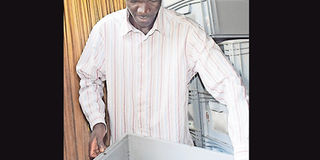Lessons from shores of Lake Victoria on rearing crickets

George Oweke, the manager of the Dunga Eco-Tourism Environmental Group's cricket farming project at their enterprise on the shores of Lake Victoria. They started the venture in June 2016 with a capital of Sh68,000 following support from Fly Food, a Dutch NGO. PHOTO | ELIZABETH OJINA | NMG
What you need to know:
- The group comprising of 28 members, a majority of them fishermen, has set up a crickets’ farm.
- Their 20ft by 10ft cricket house has 30 grey plastic crates stacked on each other in six rows.
- They started the venture in June 2016 with a capital of Sh68,000 following support from Fly Food, a Dutch NGO.
- An adult cricket weighs about 0.5-1.5 grammes, so one needs 1,000 of them to make a kilo, which they sell at Sh700.
Dunga Beach in Kisumu County is famous for its unique eco-cultural tourist attractions, some sitting amid the beautiful papyrus reeds.
A few metres from the beach on the shores of Lake Victoria, there is a boardwalk, where local and foreign tourists stand to view birds, hippos and the beautiful sunset.
At a section of the boardwalk, an interesting kind of farming is taking place courtesy of Dunga Eco-Tourism Environmental Group.
The group comprising of 28 members, a majority of them fishermen, has set up a crickets’ farm.
George Oweke, the manager of the project, leads Seeds of Gold down the wooden stairs housing the crickets.
“This is our cricket farm,” he offers. “We rear crickets as a source of food and to boost our income since our fish catch from the lake has declined,” says Oweke, noting crickets are rich in protein.
Their 20ft by 10ft cricket house has 30 grey plastic crates stacked on each other in six rows. The crates are placed on a raised board to avoid water contamination and to curb predators.
“The boardwalk stands on a swampy area, therefore, we have to contain the attack of predators such as spiders, rats and snakes,” says Oweke.
They started the venture in June 2016 with a capital of Sh68,000 following support from Fly Food, a Dutch NGO.
The capital went to the purchase of plastic crates at Sh2,500 each, sake dish, a thermometer, a book on cricket rearing and 5kg commercial feeds made from grains, fishmeal and moringa leaves.
“We started with six wild crickets which we hunted from the swamp. Today, we have 30,000 adult crickets and at least 20,000 which are in their nymph stage,” says Oweke, adding the ideal temperature for rearing crickets is between 18 to 370C.
Beside the feeds, they give them plenty of water. “As long as there are enough feeds, water and high temperature, they will breed very fast,” Oweke says, noting they feed the cricket thrice a day.
EATING EDIBLE INSECTS
The house crickets have three stages of growth in their life cycle namely the egg, nymph and the adult. They can be harvested from six weeks but their entire life cycle lasts two to three months depending on their surroundings.
Female crickets lay 100-200 eggs during their lifetime as long as the farmer provides a conducive environment for breeding.

Crickets in their housing in the enterprise. The 20ft by 10ft cricket house has 30 grey plastic crates stacked on each other in six rows. The crates are placed on a raised board to avoid water contamination and curb predators. PHOTO | ELIZABETH OJINA | NMG
“We have a sake dish with nesting materials placed in damp soil inside the egg cartons in the breeding container,” he explains, adding the eggs hatch in about 7-10 days.
An adult cricket weighs about 0.5-1.5 grammes, so one needs 1,000 of them to make a kilo, which they sell at Sh700.
They harvest up to five crates of crickets every week and sell to poultry and fish farmers.
Michael Otieno, the chairman of Dunga Fish Co-operative, says they buy 5 to 10kg of crickets once in a month for their cage fish. The society has 15 fish cages at Dunga.
“We dip them in hot water for a few minutes, dry them and feed them whole to the tilapia in the cages,” he says.
Oweke notes very few people have embraced the culture of eating edible insects.
“This is a challenge for us because if people would be eating crickets, the market would be bigger,” says Oweke.
Prof Monica Ayieko, a specialist in consumer economics at the Department of Food Security, Jaramogi Odinga Oginga University of Science and Technology, says insects can play a significant role in food security as they provide alternative protein for human consumption.
The don is rooting for the use of cricket flour to make value added products such as biscuits, cakes, mandazis, chapattis and bread.
“Eating insects is the answer to manage malnutrition and food insecurity in the Sub-Saharan Africa. Nearly every community in Africa can associate with insects eating but this is no longer actively happening. It could be termites, grasshoppers, palm weevils or crickets,” says Prof Ayieko.




